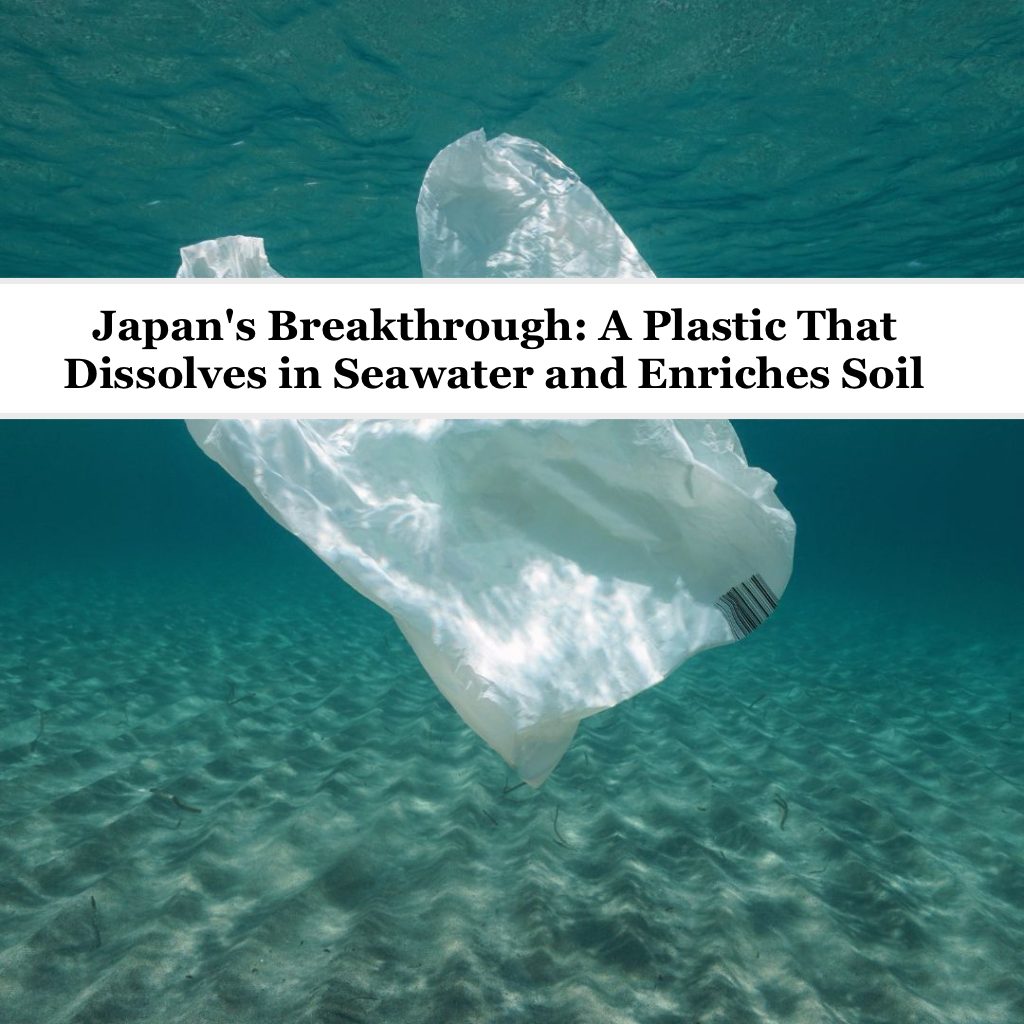Japan’s Breakthrough: A Plastic That Dissolves in Seawater and Enriches Soil source
In a significant stride towards combating plastic pollution, researchers at Japan’s RIKEN Center for Emergent Matter Science (CEMS), in collaboration with the University of Tokyo and Eindhoven University of Technology, have developed a novel plastic that dissolves in seawater within hours and decomposes in soil within days, leaving behind non-toxic, nutrient-rich byproducts. Source

🌊 A Revolutionary Solution to Plastic Pollution
Traditional plastics are notorious for their durability, often persisting in the environment for centuries and contributing to the growing crisis of microplastic pollution. This new material, however, is designed to maintain the strength and versatility of conventional plastics during use but breaks down rapidly when exposed to natural elements like seawater and soil. RIKENNew Atlas
The plastic is composed of supramolecular polymers formed by combining two ionic monomers that create cross-linked salt bridges, providing both strength and flexibility. When placed in seawater, these bonds are disrupted, causing the plastic to dissolve into harmless compounds within hours. Zero Carbon Academydesignboom+3Michele Gargiulo+3The Times of India+3
Plastic pollution is one of the biggest environmental crises of our time. Millions of tons of plastic waste choke our oceans, harm wildlife, and linger in landfills for centuries. But what if plastic could simply dissolve in water, leaving no toxic traces behind? Thanks to Japanese innovation, this futuristic solution is now a reality.
🌱 Environmental Benefits Beyond Degradation
Beyond its rapid decomposition, this innovative plastic offers additional environmental advantages. When it breaks down in soil, it releases nitrogen and phosphorus—nutrients commonly found in fertilizers—thereby enhancing soil health. This dual functionality addresses both marine pollution and soil degradation, making it a promising alternative to traditional plastics. The Times of India+1JAPAN Forward+1designboom+1Michele Gargiulo+1
🔬 Potential Applications and Future Outlook
Given its durability during use and rapid degradation post-disposal, this plastic holds potential for various applications, including packaging materials and medical devices. Its development marks a significant step towards sustainable materials that align with environmental conservation efforts. The Times of India
Why This Matters
- No More Microplastics: Traditional plastics break down into tiny, indestructible particles that infiltrate our food chain. This new plastic dissolves completely, leaving no harmful residue.
- Reduced Landfill Waste: Since the material breaks down quickly, it could drastically cut down on the plastic waste piling up in landfills.
- Safer for Marine Life: Millions of sea animals die each year from ingesting or getting entangled in plastic. A water-soluble alternative could help save countless lives.
Potential Applications
This breakthrough isn’t just a lab experiment—it has real-world uses:
- Single-Use Packaging: Imagine food wrappers, shopping bags, or straws that disappear safely after use.
- Medical Supplies: Water-soluble plastic could be used for sutures, pill coatings, or disposable medical tools that dissolve after serving their purpose.
- Agriculture: Biodegradable mulch films could dissolve into the soil instead of needing manual removal.
📸 Visualizing the Innovation
This groundbreaking development by Japanese researchers exemplifies how scientific innovation can lead to practical solutions for pressing environmental issues. As the world grapples with the challenges of plastic pollution, such advancements offer hope for a cleaner, more sustainable future.
While this innovation is promising, widespread adoption will require scaling up production and ensuring affordability. But with global plastic production expected to double by 2050, solutions like this are not just helpful—they’re essential.
Japan’s water-soluble plastic proves that sustainability and convenience can go hand in hand. If embraced globally, this could be the beginning of the end for plastic pollution.
What do you think? Please share your thoughts in the comments!
Image Source: Japan Forward






Japan’s new water-soluble plastic breakthrough could be a game-changer in tackling microplastic pollution if implemented responsibly. The key innovation here is replacing traditional petroleum-based polymers with polyvinyl alcohol (PVA) derivatives that completely dissolve in water without leaving harmful residues. What makes this particularly promising is that early tests show the material maintains strength during use but breaks down safely in marine environments. However, critical questions remain: 1) How does the lifecycle carbon footprint compare to conventional plastics? 2) Can the dissolved byproducts be safely processed by wastewater treatment systems? 3) Will it scale economically without creating new dependencies? This appears more viable than previous ‘biodegradable’ plastic attempts that required industrial composting. If these questions can be answered positively, it could revolutionize packaging and single-use items while protecting marine ecosystems. The real test will be whether manufacturers adopt it at scale and consumers properly sort it for appropriate disposal.
This is such an exciting step forward! Japan’s water-soluble, eco-friendly plastic could be a game-changer for reducing waste and protecting our oceans. 🌊♻️
This breakthrough is incredibly exciting! 🌱 Japan’s water-soluble, eco-friendly plastic could be a real game-changer in the fight against plastic pollution. It’s inspiring to see innovation focused on sustainability. Hoping more countries follow suit and invest in solutions like this! 💧♻️
Japan’s water-soluble plastic innovation is a fascinating step toward tackling plastic pollution—but the real test will be scalability and real-world impact. Unlike traditional ‘biodegradable’ plastics that require specific conditions to break down, this material truly dissolves in water, leaving no microplastics behind. That’s revolutionary for single-use items like packaging, tea bags, or even hospital applications where sterile disposal matters.
However, key questions remain:
Does production still rely on fossil fuels? (Many ‘eco-plastics’ still use petrochemical feedstocks.)
What happens to the dissolved byproducts? If they alter water chemistry, we could trade one problem for another.
Will companies adopt it? Without policy shifts, cost may still favor conventional plastic.
This feels like the first chapter in a bigger story—one where science, policy, and consumer demand all have to align. Cautiously optimistic!